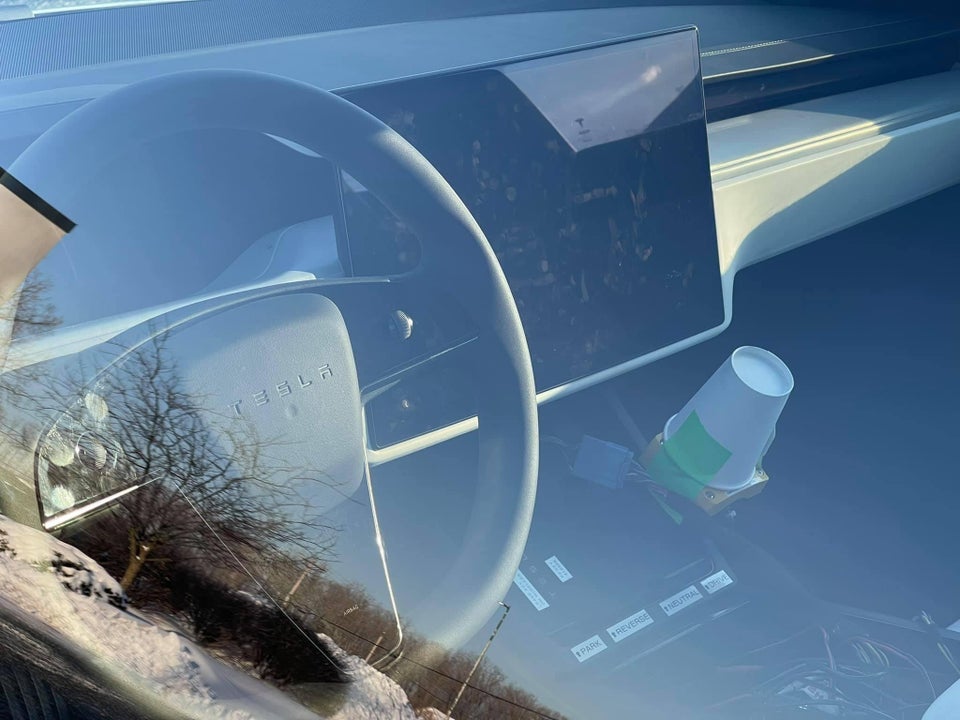
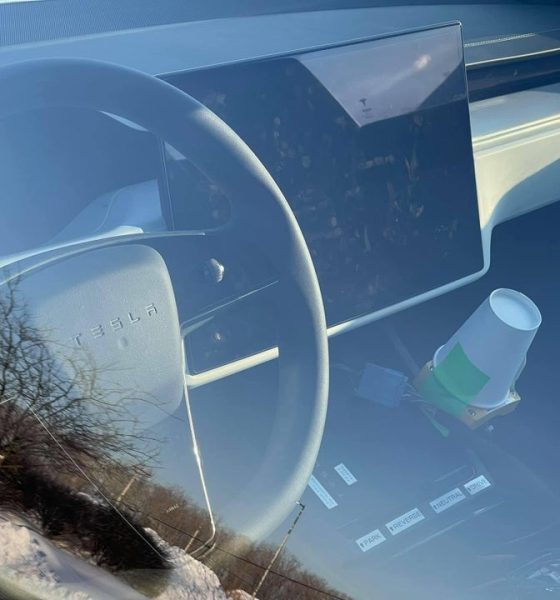
News
Tesla Model S ‘Refresh’ test vehicle interior: New Steering Wheel, Touchscreen, HVAC system
The first images of the Tesla Model S “Refresh” have landed online, after a person in Toledo, Ohio, spotted the newly-designed sedan at the Toledo Service Center. After speaking with Service Center employees, it has been confirmed that this is a test vehicle. However, images show that the Model S interior is here, and preliminary designs are in the works.
Upon the release of the Q4 2020 Earnings Call Update Letter, Tesla released new photographs of the Model S interior. Rumors that Tesla’s flagship sedan was going to be subjected to a “refresh” were spinning through the rumor mill since December 2020, after the company shut down production lines of the Model S and Model X at the Fremont factory. The vehicle was then spotted at the Fremont Test Track by Teslarati and the Kilowatts, further confirming that Tesla was revamping its flagship vehicle.
While exterior photos showed some changes, many were interested in whether Tesla would modify the interior design. It did, after confirming some new features in photographs that were included in the Q4 2020 Shareholder Deck. A new Yoke Steering wheel, horizontal touchscreen, and rear passenger screen were all included, along with modifications to the vehicle’s HVAC design, center console, and others.
Now, new images have surfaced of the Model S interior, thanks to Tom of the Tesla Owners Club of Michigan Facebook group. These photographs were then shared to the r/TeslaMotors Subreddit.
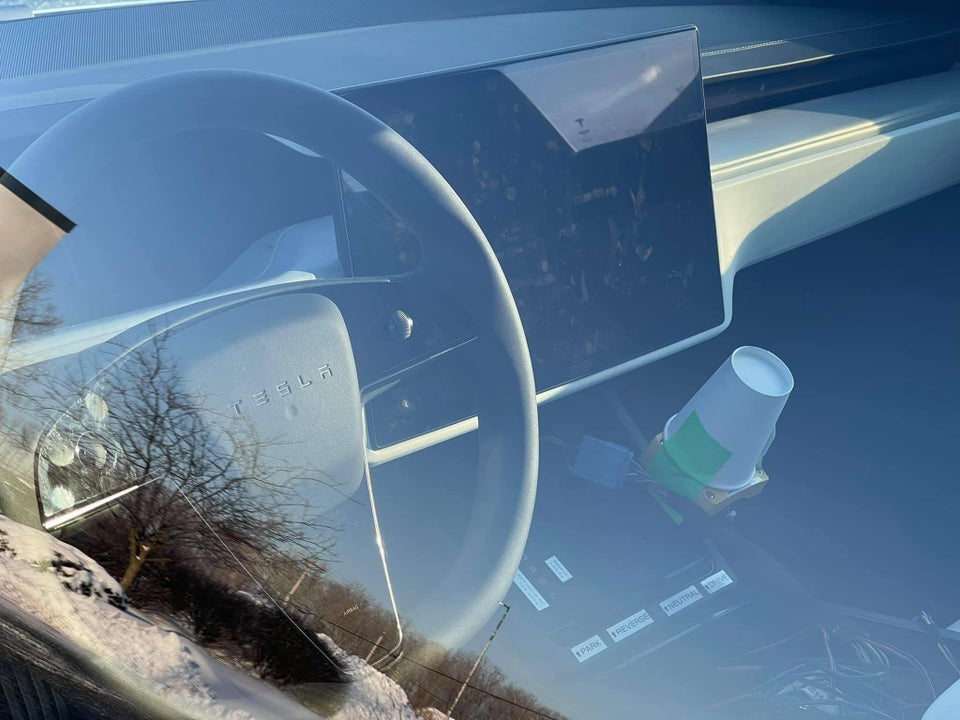
Credit: Tesla Owners Club of Michigan | Facebook
It appears that Tesla’s Yoke Steering Wheel will be optional and can be equipped with a new steering column design. The new steering wheel is noticeably different than past Model S steering wheels. The center of the wheel seems to have a cap for the horn instead of the past one-piece design that has been used.
As far as the Yoke design, the NHTSA has told Teslarati on several occasions that it will work with the automaker on the regulations regarding steering wheel shape. The Yoke has been approved in several other countries, but the NHTSA still hasn’t confirmed whether it will be allowed or not.
The NHTSA told Teslarati:
“At this time, NHTSA cannot determine if the steering wheel meets Federal Motor Vehicle Safety Standards. We will be reaching out to the automaker for more information.”
It also appears that this vehicle is undergoing some kind of testing as there are plenty of exposed wires and labels on the interior. Tesla has been known to test upcoming vehicles in a number of different conditions, including snow. Several past vehicle prototypes have run spirited drives in challenging, snowy conditions ahead of their releases. The Model Y and Semi are just two of them.
Tom, the original poster in the Facebook Group, stated that:
“Model S refresh test vehicle spotted at the Toledo service center!! Sorry for the crummy photos. Best I could do at the time. Also, yoke steering wheel confirmed as option, by service staff!!”
Credit: Tesla Owners Club of Michigan | Facebook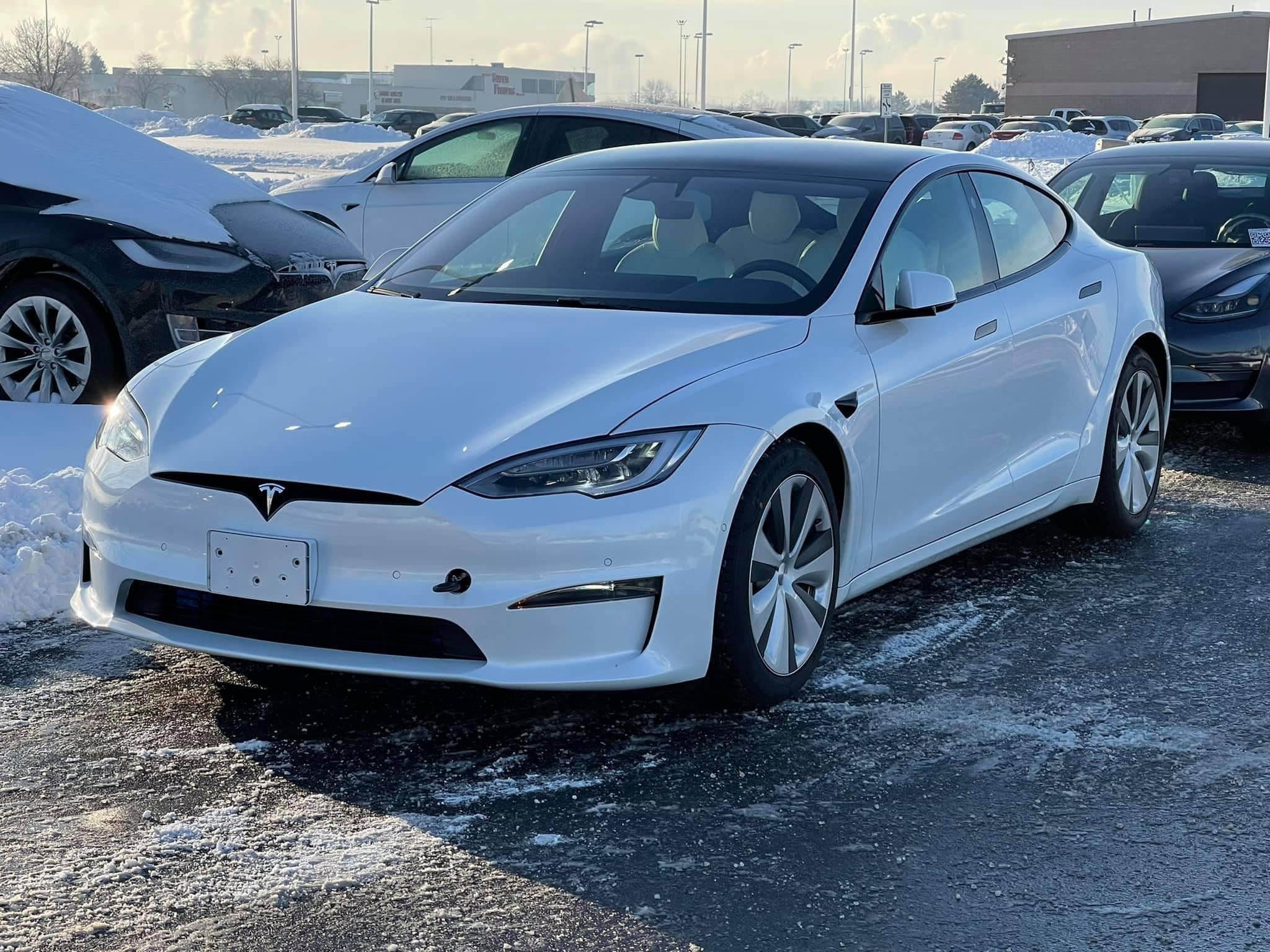
Tesla is currently producing the refreshed Model S and Model X at the Fremont Factory, and has contacted orderers about their possible delivery dates. One Model X reservation holder told Teslarati earlier this month that his planned delivery date is between February 15th and March 15th, meaning that the new vehicles could be rolling into customer driveways any day now.
Tesla’s Crash Testing History in Ohio
While unclear for the exact reasoning that Tesla sent a Model S Refresh to Ohio, there is some history with Tesla’s soon-to-be-released cars in the state. In 2017 before the Model 3 was officially released and began deliveries, Tesla sent almost 100 Model 3s to Central Ohio for crash testing.
According to @Model3Owners, Tesla was sending the Model 3s to an independent crash safety testing facility, run by the Transportation Research Center‘s “Smart Mobility Advanced Research Test Center,” a $45 million facility that sits on 540 acres. Ohio State University and the Ohio Department of Transportation both donated at least $20 million to the facility that tests a wide variety of crash scenarios for automakers.
With the Model S having a new design, it is possible that Tesla could be sending the new car, along with several others, to the Transportation Research Center facility to test its performance in accidents. While the Model S already holds a five-star crash safety rating from the NHTSA, the slightly refined body design could need some additional research from Tesla to keep its great reputation for making safe vehicles.

News
Tesla Cybercab tests are going on overdrive with production-ready units
Tesla is ramping its real-world tests of the Cybercab, with multiple sightings of the vehicle being reported across social media this week.

Tesla is ramping its real-world tests of the Cybercab, with multiple sightings of the autonomous two-seater being reported across social media this week. Based on videos of the vehicle that have been shared online, it appears that Cybercab tests are underway across multiple states.
Recent Cybercab sightings
Reports of Cybercab tests have ramped this week, with a vehicle that looked like a production-ready prototype being spotted at Apple’s Visitor Center in California. The vehicle in this sighting was interesting as it was equipped with a steering wheel. The vehicle also featured some changes to the design of its brake lights.
The Cybercab was also filmed testing at the Fremont factory’s test track, which also seemed to involve a vehicle that looked production-ready. This also seemed to be the case for a Cybercab that was spotted in Austin, Texas, which happened to be undergoing real-world tests. Overall, these sightings suggest that Cybercab testing is fully underway, and the vehicle is really moving towards production.
Production design all but finalized?
Recently, a near-production-ready Cybercab was showcased at Tesla’s Santana Row showroom in San Jose. The vehicle was equipped with frameless windows, dual windshield wipers, powered butterfly door struts, an extended front splitter, an updated lightbar, new wheel covers, and a license plate bracket. Interior updates include redesigned dash/door panels, refined seats with center cupholders, updated carpet, and what appeared to be improved legroom.
There seems to be a pretty good chance that the Cybercab’s design has been all but finalized, at least considering Elon Musk’s comments at the 2025 Annual Shareholder Meeting. During the event, Musk confirmed that the vehicle will enter production around April 2026, and its production targets will be quite ambitious.
News
Tesla gets a win in Sweden as union withdraws potentially “illegal” blockade
As per recent reports, the Vision union’s planned anti-Tesla action might have been illegal.
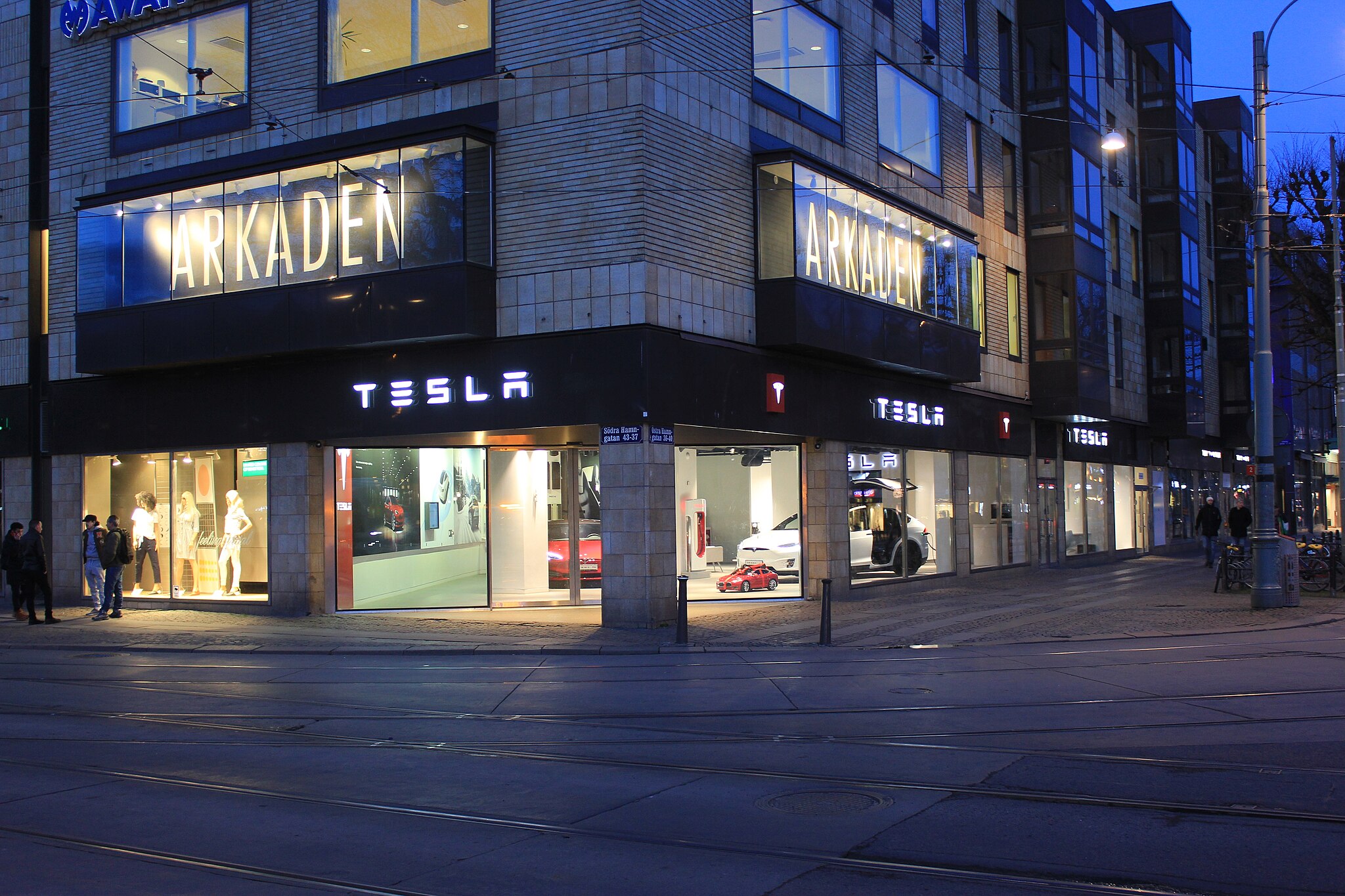
Swedish union Vision has withdrawn its sympathy blockade against Tesla’s planned service center and showroom in Kalmar. As per recent reports, the Vision union’s planned anti-Tesla action might have been illegal.
Vision’s decision to pull the blockade
Vision announced the blockade in early December, stating that it was targeting the administrative handling of Tesla’s facility permits in Kalmar municipality. The sympathy measure was expected to start Monday, but was formally withdrawn via documents sent to the Mediation Institute and Kalmar Municipality last week.
As noted in a Daggers Arbete report, plans for the strike were ultimately pulled after employer group SKR highlighted potential illegality under the Public Employment Act. Vision stressed its continued backing for the Swedish labor model, though Deputy negotiation manager Oskar Pettersson explained that the Vision union and IF Metall made the decision to cancel the planned strike together.
“We will not continue to challenge the regulations,” Petterson said. “The objection was of a technical nature. We made the assessment together with IF Metall that we were not in a position to challenge the legal assessment of whether we could take this particular action against Tesla. Therefore, we chose to revoke the notice itself.”
The SKR’s warning
Petterson also stated that SKR’s technical objection to the Vision union’s planned anti-Tesla strike framed the protest as an unauthorized act. “It was a legal assessment of the situation. Both for us and for IF Metall, it is important to be clear that we stand for the Swedish model. But we should not continue to challenge the regulations and risk getting judgments that lead nowhere in the application of the regulations,” he said.
Vision ultimately canceled its planned blockade against Tesla on December 9. With Vision’s withdrawal, few obstacles remain for Tesla’s long-planned Kalmar site. A foreign electrical firm completed work this fall, and Tesla’s Careers page currently lists a full-time service manager position based there, signaling an imminent opening.
News
Tesla Semi program Director teases major improvements
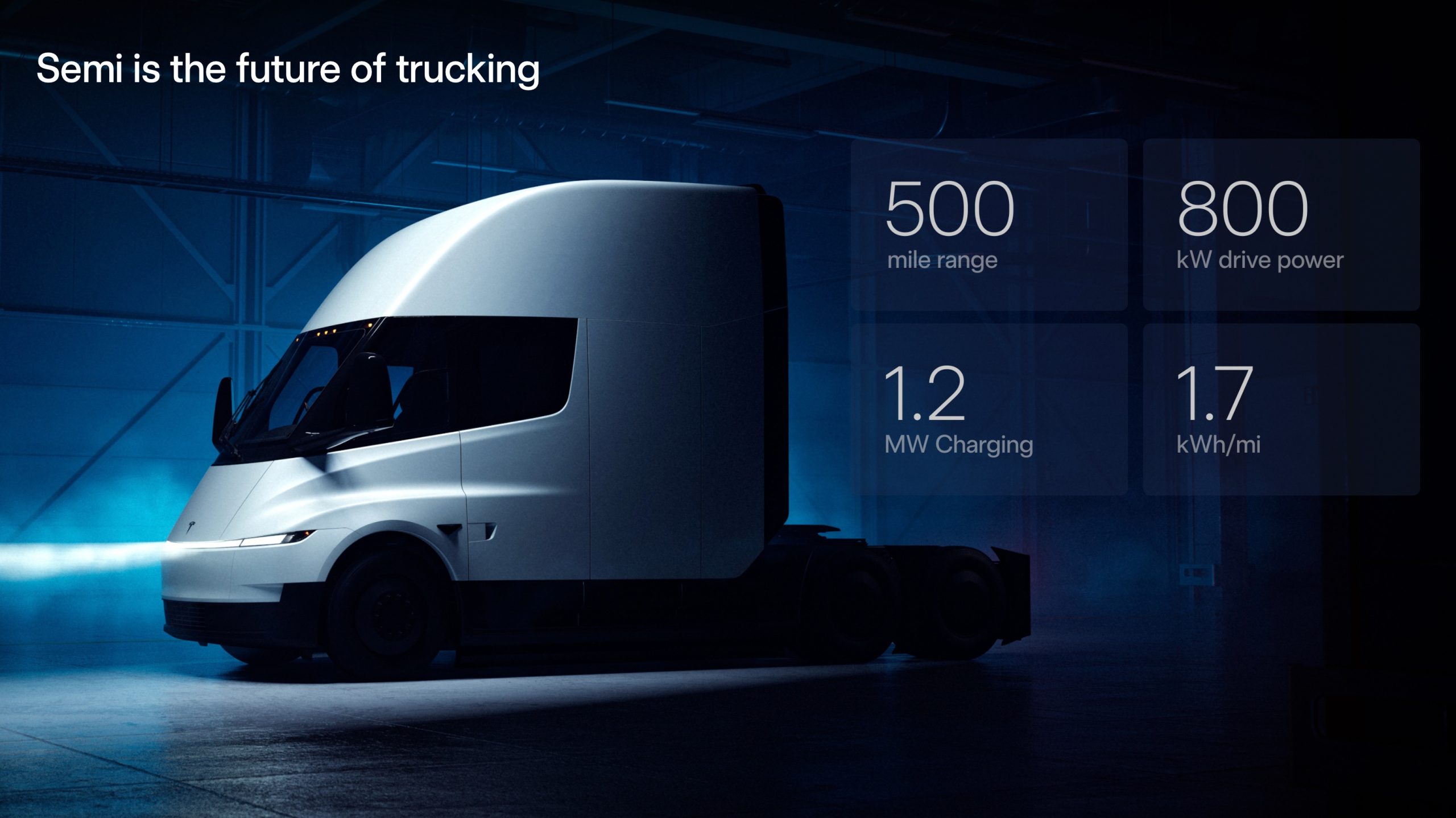
Tesla Semi Program Director Dan Priestly teased the major improvements to the all-electric Class 8 truck on Thursday night, following the company’s decision to overhaul the design earlier this year.
Priestley said he drove the Semi on Thursday, and the improvements appear to be welcomed by one of the minds behind the project. “Our customers are going to love it,” he concluded.
Just drove the redesigned Semi. Our customers are going to love it. https://t.co/KZ88sf1CDL
— Dan Priestley (@danWpriestley) December 19, 2025
The small detail does not seem like much, but it is coming from someone who has been involved in the development of the truck from A to Z. Priestley has been involved in the Semi program since November 2015 and has slowly worked his way through the ranks, and currently stands as the Director of the program.
Tesla Semi undergoes major redesign as dedicated factory preps for deliveries
Tesla made some major changes to the Semi design as it announced at the 2025 Annual Shareholder Meeting that it changed the look and design to welcome improvements in efficiency.
Initially, Tesla adopted the blade-like light bar for the Semi, similar to the one that is present on the Model Y Premium and the Cybertruck.
Additionally, there are some slight aesthetic changes to help with efficiency, including a redesigned bumper with improved aero channels, a smaller wraparound windshield, and a smoother roofline for better aero performance.
All of these changes came as the company’s Semi Factory, which is located on Gigafactory Nevada’s property, was finishing up construction in preparation for initial production phases, as Tesla is planning to ramp up manufacturing next year. CEO Elon Musk has said the Semi has attracted “ridiculous demand.”
The Semi has already gathered many large companies that have signed up to buy units, including Frito-Lay and PepsiCo., which have been helping Tesla test the vehicle in a pilot program to test range, efficiency, and other important metrics that will be a major selling point.
Tesla will be the Semi’s first user, though, and the truck will help solve some of the company’s logistics needs in the coming years.








